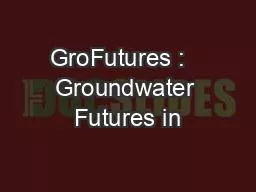PPT-GroFutures : Groundwater Futures in
Author : brambani | Published Date : 2020-10-22
SubSaharan Africa UpGro Consortium grant 201519 Understanding climate impacts on Groundwater Martin Todd University of Sussex mtoddsussexacuk Context Africa is
Presentation Embed Code
Download Presentation
Download Presentation The PPT/PDF document "GroFutures : Groundwater Futures in" is the property of its rightful owner. Permission is granted to download and print the materials on this website for personal, non-commercial use only, and to display it on your personal computer provided you do not modify the materials and that you retain all copyright notices contained in the materials. By downloading content from our website, you accept the terms of this agreement.
GroFutures : Groundwater Futures in: Transcript
SubSaharan Africa UpGro Consortium grant 201519 Understanding climate impacts on Groundwater Martin Todd University of Sussex mtoddsussexacuk Context Africa is changing rapidly and demand for . 6. th. Edition, Copyright . © John C. Hull 2005. 20.. 1. Credit Risk. Chapter 20. Options, Futures, and Other Derivatives. 6. th. Edition, Copyright . © John C. Hull 2005. 20.. 2. Credit Ratings. Topic 10. I. Futures Markets. 2. A. Forward vs. Futures Markets. 1. Forward contracting involves a contract initiated at one time and performance in accordance with the terms of the contract occurring at a subsequent time. . 22: Hedging, Speculation, and Arbitrage. Futures. Hedge. use futures to reduce risk on an existing position. Speculate. use futures to take on risk in the hope of making a profit. Arbitrage. Use the difference between spot and futures prices to generate risk-free profit . One World One People. What is Global Citizenship?. Global . (of or relating to the world). . citizenship. . (the status of a citizen-. a legally recognized subject or national of a state, either native or naturalized; . $ versus . ¥ Nikkei 225 Index Futures. 1. Christopher Ting. Learning Objectives. Define quanto. Understand inter-market spread trading strategy. Analyze the P&L of a short quanto position. 2. Quanto. 6. th. Edition, Copyright . © John C. Hull 2005. 1. 8.. 1. Chapter 18. Value at Risk. Options, Futures, and Other Derivatives. 6. th. Edition, Copyright . © John C. Hull 2005. 1. 8.. 2. History of VaR. Tools and methods for futures guidance . . SIEC . conference. 8.8.2014. Leena Jokinen . Univeristy. of Turku. Finland . Futures. . Research. Centre . www.ffrc.utu.fi. leena.jokinen@utu.fi. Content. Japan. Started in Japan in early 1700s with Rice Futures . Chicago. But it wasn't until the mid-19th century that the true birth of the modern futures markets and futures contracts began . Chicago Board of Trade (CBOT) was established in 1848 . 22: Speculation. Futures. Hedge. use futures to reduce risk on an existing position. Speculate. use futures to take on risk in the hope of making a profit. Arbitrage. Use the difference between spot and futures prices to generate risk-free profit . Lecture 19: Devising a Real-World Hedging Strategy: Optimal Hedge Ratio. (Part 2). Nick . Piggott & Wally Thurman. NCSU Agricultural & Resource Economics. March . 21, 2016. 11.45 am – 1.00pm. . Issued Quarterly January 2017 . Newsletter January 2017. . If you have any news, suggestions, kudos, thank you’s or thoughts, please let Eric know in person, by phone at 403-531-8631 ext 205, or by email at . February 2016. The UWA Futures Observatory opened in November 2015 to provide a focus for the Centre for Education Futures’ Scholarship and Innovation stream. . Its . purpose is to:. Promote . and encourage UWA’s future thinking . Options, Futures, and Other Derivatives, 8th Edition, . Copyright © John C. Hull 2012. 1. Long & Short Hedges. A long futures hedge is appropriate when you know you will purchase an asset in the future and want to lock in the price. Who wants FREE money to go to college!. Bright Futures . Grant. Grant Information. Annual Deadlines Dates for Application & Enrollment: . Fall Semester - June . 30. th. . Spring Semester - .
Download Document
Here is the link to download the presentation.
"GroFutures : Groundwater Futures in"The content belongs to its owner. You may download and print it for personal use, without modification, and keep all copyright notices. By downloading, you agree to these terms.
Related Documents














